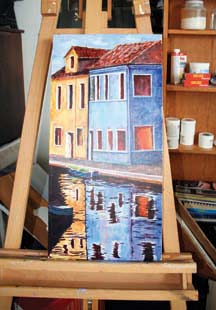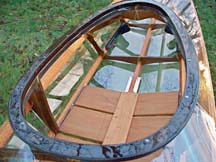Do-it-yourself Doug
A man with a "can-do" attitude
By Isabelle Southcott
He's builds and renovates houses. He roasts his own coffee beans. He grows garlic. He fixes old cars. He's a talented painter. He's a pilot. He plays guitar and mouth harp. He builds kayaks. He's a minister.
In fact, there is not much that Doug Schuetze can't do.
Oh, did I mention he's incredibly enthusiastic and loves learning something new?
Doug and his wife Val moved to Powell River from Victoria four years ago. "We started visiting up here and just loved it," says Doug. "We got off the ferry one day and I thought, I wish we were coming home." The couple bought an old 1920s home and gutted it. "This small part of drywall is all that's original here," says Doug pointing to a wall in the dining room. "We knocked the walls out and changed the layout." The hardwood floors look old and they are. The wood came from a turn of the century home in Victoria.
"I totally love renovating," Doug says. His kids tease him, saying that he took five of the ugliest houses in Powell River and renovated them. He lists off the house on King, the house on Maple, the house on Cranberry, the house on Tweedsmuir and the one he lives in, the house on Marine.
Doug inherited his do-it-yourself attitude from his father. "Dad did everything. He was a mechanic. He was a welder. He could fix or make anything. I remember when he took an old wartime Harley that he bought in boxes, put it together and made it beautiful. "My best day in Grade 12 was when he let me take the old Harley 45 to school." He built a couple of boats, sewed his own sails and even made his own boat trailer." "Doug's dad was amazing," interjects Val. "Look," she says producing an aluminum cookie sheet. "He made that."
Doug believes do-it-yourselfers beget do-it-yourselfers. "Because of my dad's example and influence my brother and I both learned to fearlessly take on any project. My son Dan is a can-do man. He restores and builds houses, fixes cars, motorcycles and just about anything else. When I start doing things I get excited. God made us to be creative. Society has gone the opposite way and I think that is one of the problems with young kids. They play video games all the time and can easily miss out accomplishing anything in the real world," he says.
Doug, who spent many years as a missionary in both Mexico and Spain, besides giving Bible classes, ran an autobody shop in a Christian drug and alcohol rehabilitation center in northern Spain. "Our main focus was on their spiritual need but we also taught them practical skills like hard work, honesty, perseverance and getting along with others in order to help them function in their new lives when they left the center."
Doug will try his hand at almost anything. He's curious and he likes to save money. "I'm basically a cheapskate," he admits. Val laughs. "Doug says okay, this needs to be done, so how can I do it?" The stonework at the base of their house is one example of something that needed to be done. "It was too expensive to have it done with store-bought products," Doug says. So he went on e-bay and found moulds. He poured the concrete and painted it the colour he wanted it.
Doug does theming and décor work for theme parks and recreation centres so he has experience to draw on. He makes sculpted rocks, does murals, creates fake trees and painted facades. "He is very artistic; he has a very good eye," says his wife. "He never thinks he can't do it. When he is in bed at night, he is often pre-building something in his mind!"
Doug's interest in discovering why and how seems to have no end. When he wanted a perfect cup of coffee at an affordable price, he did his homework. He learned that green coffee beans last for 20 months in an airtight bag. "Once they're roasted they last about 20 days and once they're ground, they last 15 to 20 minutes before most of the flavour is gone." Green coffee beans cost $5 a pound whereas freshly roasted coffee beans cost $18 to $20 a pound, he says.
"I don't even know how he got into that," says Val.


Just do it: Doug Schuetze roasts his own coffee beans in a home-made roaster.
And in his spare time, dabbles with a little painting.
Doug made his own coffee roaster out of an old bread machine and convection oven, bought a good grinder and espresso machine. In his quest for the perfect cup of coffee he learned that grind and temperature have to be precise. "The most important piece of equipment for a coffee lover is the grinder," he says. "The beans need to be uniformly ground or else all of the coffee won't get extracted evenly," he adds, bleeding the first bit of hot water off his espresso machine. After carefully measuring out freshly ground beans, Doug levels them off and gives them a five-pound tamp followed by a 30-pound tamp. "You should do two ounces in 25 seconds," he says.
The result? A fabulous cup of espresso with perfect crma, that thin layer of foam on top.
Doug and Val are an interesting couple. After 12 years as missionaries living in Spain and Mexico they returned to Canada for the next step on their journey. Young adults filled their home and Doug began to mentor them and teach them about cars and body work, paint and mechanics along with much needed life skills.
Six years ago, after their three children left the nest, Val said she prayed they would find something they could do together. She began to draw and paint and not long after Doug did as well. Their work is far from amateur looking; it's better than many paintings produced by artists who have been painting far longer than either of them has.
And then there are the kayaks that Doug built and his website that tells the world about it.



Home built: These beautiful kayaks were hand-made by do-it-yourselfer Doug Schuetze.
"She led me into kayaks," says Doug. "Val rented one, and loved it. So she bought one for $1200." That kayak was too small for Doug so he bought a second-hand one. "It was one of those old klunky ones. I paddled it around and thought it was neat." But with winter coming, Doug needed a project. "I didn't want to just sit around in front of the TV all winter." So he researched how to build a kayak and figured it out.
He built his first kayak and covered it with bullet-proof nylon and finished it with urethane. It is 17 feet long and weighs 30 pounds. "It's super tough; this stuff does not rip. You can go up on the rocks with it." The next kayak is see-through. "This is so cool. You can look right through this one," he says excitedly. Kayak number two is a thing of beauty. Warm wood finished to a high shine is used for the frame. It is covered with a transparent vinyl and according to Doug "it is the envy of every onlooker." It is affordable and weights only 30 pounds. When Doug is in it, he can see the sea life beneath him as he paddles up and down the coast. For more photos or information on Cruz Kayaks, visit Doug's website: cruzkayaks.com. (I didn't ask him but I suspect he built the website himself).
Doug loves learning new things. He bought a juicer last year and he and Val can extract 80 litres of juice in an afternoon. "We just go knocking on doors and ask, are you picking your apples?"
Is there anything that Doug doesn't do? I ask. He smiles. "I don't ballet dance," he says firmly.